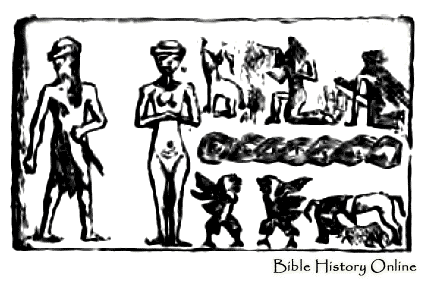

Tammuz’s retreat to the underworld, generally said to occur at the summer solstice when the weather turns hot and dry, brought the end of fertility of plants, animals, and humans. During the Sumerian Festival of Tammuz, the king took on Tammuz’s identity and mated with a priestess this act was said to ensure the fertility of crops and animals for the year. Because of this and his early identification as a shepherd, Tammuz in all his forms is known as the god of fertility and agriculture. Whether we’re talking about Dumuzid, Tammuz, Osiris, or Adonis, the theme of death and resurrection runs through the mythology. Zeus honored Aphrodite’s mourning by allowing him to remain above ground half the year. Sometime later, Adonis was killed by a boar. Zeus finally intervened, declaring Adonis had to stay four months with Persephone, four months with Aphrodite, and four months wherever he pleased.

Persephone fell for the beautiful child, as well, and the sisters fought. Aphrodite gave the infant Adonis to her sister Persephone to protect in the underworld.

In Greece, Ishtar and Tammuz seem to have inspired the story of Aphrodite and Adonis. In appreciation for Isis’ devotion, the gods made Osiris the leader of the underworld, the Nile (whose tides ebb and flow, bringing life and death), and agriculture (with its cycle of dormancy and restoration). Accounts vary, but somehow Isis brought Osiris back to life in time to sire Horus before he was killed again. Osiris, married to the faithful Isis, was killed by his brother Set for his throne. The story of Inanna and Dumuzid spread beyond the Sumerian and Akkadian Empires to other cultures. Eventually, Inanna/Ishtar regretted her extreme measures, and the gods compromised by having Dumuzid/Tammuz and his sister alternate time in the underworld.Īnother version says Inanna/Ishtar went to the underworld to rescue Dumuzid/Tammuz after he was killed by underworld raiders. He hid in the home of his sister, Geshtinana, but the demons eventually caught up to him and dragged him to the underworld. In retaliation for his lack of devotion, Inanna/Ishtar set her demons on Tammuz. Eventually she found her husband, Dumuzid/Tammuz, dressed in rich clothing and sitting on her throne. She scoured the world, looking for someone who wasn’t mourning her death. Enki/Ea allowed her to be resurrected, but she had to find another soul to take her place. While Inanna/Ishtar was dead, sexual relations ceased over the entire universe. For her hubris, Ishtar was condemned by the Anunnaki (judges of the underworld) and sentenced to be killed and her corpse hung from a nail or hook.

The most common story is that Ishtar travelled to the netherworld to take the throne of her sister, Ereshkigal. Tammuz was known as “the good, young one,” and his beauty caught the attention of Inanna (known to the Akkadians as Ishtar), who took him for her consort. In the later Akkadian mythos, he was the god of agriculture. In the earlier Sumerian culture, Dumuzid/Tammuz was the god of sheep, lambs, and sheep’s milk-a pastoral deity. His father was the ancient Mesopotamian god Enki, and his mother was the sheep goddess Duttur. Tammuz the demigod apparently began as a Sumerian shepherd named Dumu-zid or Dumuzi. God calls the idolatrous practice of weeping for Tammuz a “detestable” thing, made even worse in that it was happening at the temple in Jerusalem. The prophet describes a vision he had, saying the Lord “brought me to the entrance of the north gate of the house of the LORD, and I saw women sitting there, mourning the god Tammuz” (Ezekiel 8:14). The false god Tammuz is mentioned in the book of Ezekiel.


 0 kommentar(er)
0 kommentar(er)
